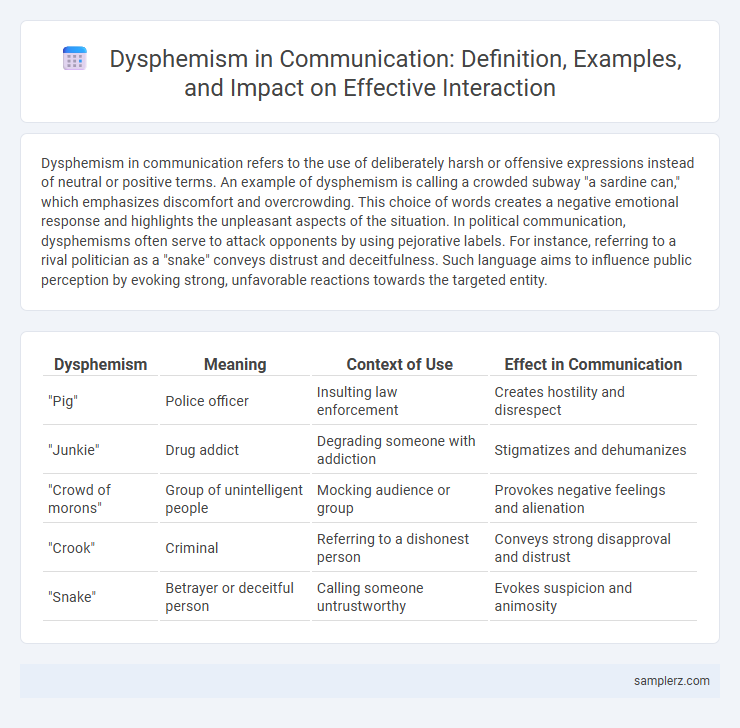Dysphemism in communication refers to the use of deliberately harsh or offensive expressions instead of neutral or positive terms. An example of dysphemism is calling a crowded subway "a sardine can," which emphasizes discomfort and overcrowding. This choice of words creates a negative emotional response and highlights the unpleasant aspects of the situation. In political communication, dysphemisms often serve to attack opponents by using pejorative labels. For instance, referring to a rival politician as a "snake" conveys distrust and deceitfulness. Such language aims to influence public perception by evoking strong, unfavorable reactions towards the targeted entity.
Table of Comparison
| Dysphemism | Meaning | Context of Use | Effect in Communication |
|---|---|---|---|
| "Pig" | Police officer | Insulting law enforcement | Creates hostility and disrespect |
| "Junkie" | Drug addict | Degrading someone with addiction | Stigmatizes and dehumanizes |
| "Crowd of morons" | Group of unintelligent people | Mocking audience or group | Provokes negative feelings and alienation |
| "Crook" | Criminal | Referring to a dishonest person | Conveys strong disapproval and distrust |
| "Snake" | Betrayer or deceitful person | Calling someone untrustworthy | Evokes suspicion and animosity |
Understanding Dysphemism in Everyday Communication
Dysphemism in everyday communication involves using harsh or offensive language to describe something neutral or positive, often to evoke strong emotional reactions or convey disdain. For example, calling a police officer a "pig" demonstrates a dysphemistic expression that replaces a neutral term with a provocative one to emphasize negativity. Understanding dysphemism helps recognize the intention behind word choices and the impact on social interactions and discourse dynamics.
Common Examples of Dysphemism in Conversations
Common examples of dysphemism in conversations include using words like "pig" to insult someone perceived as messy or greedy, replacing neutral terms such as "police officer" with "cop" to imply derogatory tones, and referring to a disliked person as a "snake" to suggest deceitfulness. These expressions serve to convey strong negative emotions, often intensifying conflicts or misunderstandings in interpersonal communication. Employing dysphemism contrasts with euphemisms by purposely choosing harsher language to impact the listener's perception.
Dysphemism in Media and Pop Culture
Dysphemism in media and pop culture often manifests through derogatory nicknames or harsh labels aimed at public figures, intensifying negative perceptions and emotional reactions. Television shows, movies, and social media platforms frequently use dysphemistic language to create strong characterizations or satirical effects, influencing audience attitudes and reinforcing stereotypes. This strategic use of offensive or blunt expressions exploits the power of language to evoke shock, humor, or criticism, shaping public discourse and cultural narratives.
Impact of Dysphemism on Interpersonal Relationships
Calling a colleague "incompetent" instead of "unskilled" serves as a stark example of dysphemism in communication, which can severely damage trust and respect in interpersonal relationships. Such negative language escalates conflicts and creates emotional barriers, hindering effective collaboration and emotional connection. The impact of dysphemism often results in increased misunderstandings and long-term resentment between individuals.
Dysphemism Versus Euphemism: Key Differences
Dysphemism employs harsh or offensive language to convey negative connotations, such as using "croaked" instead of "died," contrasting with euphemism's softer expressions like "passed away." Dysphemisms intensify emotional responses or emphasize disapproval, while euphemisms aim to mitigate discomfort and maintain politeness. Understanding these differences is crucial for effective communication, as dysphemism can provoke offense or humor depending on context, unlike the often neutralizing effect of euphemism.
Dysphemism in Political Discourse
Dysphemism in political discourse often involves the use of harsh or derogatory language to undermine opponents, such as labeling policies as "disasters" or referring to opponents as "radicals" or "saboteurs." This rhetorical strategy intensifies emotional reactions and polarizes audiences by framing political debates in negative and confrontational terms. By employing dysphemistic expressions, politicians aim to delegitimize opposing viewpoints and consolidate support within their own factions.
How Dysphemism Shapes Public Perception
Dysphemism, such as using terms like "scumbag" instead of "untrustworthy person," intensifies negative emotions and can distort public perception by reinforcing hostility or bias toward an individual or group. In political communication, calling opponents "liars" rather than "disagreeing parties" exacerbates division and polarizes audiences, shaping societal attitudes through language that evokes contempt. This strategic use of dysphemism influences the public discourse by framing issues in a derogatory light, often hindering constructive dialogue and perpetuating stereotypes.
Dysphemism in Workplace Communication
Dysphemism in workplace communication manifests through derogatory terms or harsh language used to criticize colleagues or management, often damaging morale and professional relationships. Examples include calling a manager a "bossy dictator" or labeling a coworker's idea as a "stupid suggestion," which can create a hostile environment and reduce team collaboration. Such negative language not only undermines constructive dialogue but also increases workplace stress and decreases overall productivity.
Strategies to Address Dysphemism in Dialogue
Dysphemism in communication, such as using harsh or offensive language to provoke emotional reactions, requires strategic interventions to maintain constructive dialogue. Effective strategies include reframing negative expressions with neutral or positive synonyms, employing active listening to understand underlying concerns, and setting clear conversational boundaries to discourage disrespectful language. These approaches promote respectful exchanges and reduce the impact of dysphemistic remarks in interpersonal or professional settings.
Cultural Variations of Dysphemism in Communication
Dysphemism in communication varies significantly across cultures, reflecting distinct social norms and taboos. For example, in Japanese culture, direct insults are often replaced with subtle, indirect phrases to avoid overt confrontation, while in some Western cultures, explicit language might be more common in casual settings. Understanding these cultural variations of dysphemism is crucial for effective intercultural communication and preventing misunderstandings.

example of dysphemism in communication Infographic
 samplerz.com
samplerz.com